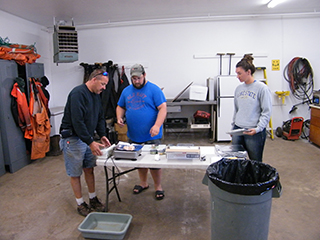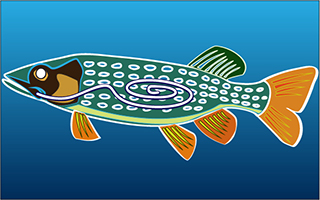Partnerships for Environmental Public Health (PEPH)
Study Location: Vilas County, Wisconsin; Chippewa County, Michigan
Academic Partners:
Medical College of Wisconsin
Matthew Dellinger, Ph.D.
University of Wisconsin, Milwaukee, Mobile App Innovation Lab
Dustin J. Hahn
Community Partners:
Great Lakes Inter Tribal Council, Inc.
Inter Tribal Council of Michigan
Robin Clark
Noel Pingatore
Chippewa Ottawa Resource Authority
Michael Ripley
Project Description

David Pine, a fisheries technician (far left), works with Native American graduate students Chad Lafaver (second from left) and Whitney Frazier (right) to analyze fish samples for the project. Lafaver and Frazier are both members of the Sault Ste. Marie Tribe of Chippewa Indians.
(Photo courtesy of Matthew Dellinger, Ph.D.)
This project seeks to transform fish consumption advice for Native American tribal communities living in and around the Great Lakes. These communities are collectively known and referred to as the Anishinaabe. Ongoing concern about the presence of pollutants in the Great lakes that accumulate in fish, called persistent bioaccumulative toxics (PBTs), has led to numerous fish consumption advisories. Fish are an important part of the Anishinaabe diet and culture. There is a need to promote environmental health in these tribal communities and communicate the benefits of fish, but not increasing the risks of PBT exposure.

Woodland art image of a pike fish from the Gigiigooinann mobile app.
(Photo courtesy of Matthew Dellinger, Ph.D.)
Investigators will update and test the effectiveness of an interactive, culturally-tailored mobile application, called Gigiigooinaan (which means Our Fish), which was developed with community input as part of a previously funded NIEHS grant. The mobile app delivers personalized consumption advice on species of fish commonly consumed by the tribal communities and addresses key concerns related to environmental health and education for the Anishinaabe.
This project builds upon an existing 13-year collaborative partnership with two Anishinaabe inter-tribal consortia and their communities and provides a great opportunity to evaluate the effectiveness of the mobile app on dietary choices.
Specific aims of the project are to:
- Assemble PBT and polyunsaturated fatty acid concentrations for 25 fish species to be incorporated in an update of the mobile app.
- Update the mobile app with new features and community recommendations using perception and utility data collected from three focus groups of Anishinaabe tribal members.
- Conduct a randomized, controlled experiment to test health and behavioral changes from app usage.


